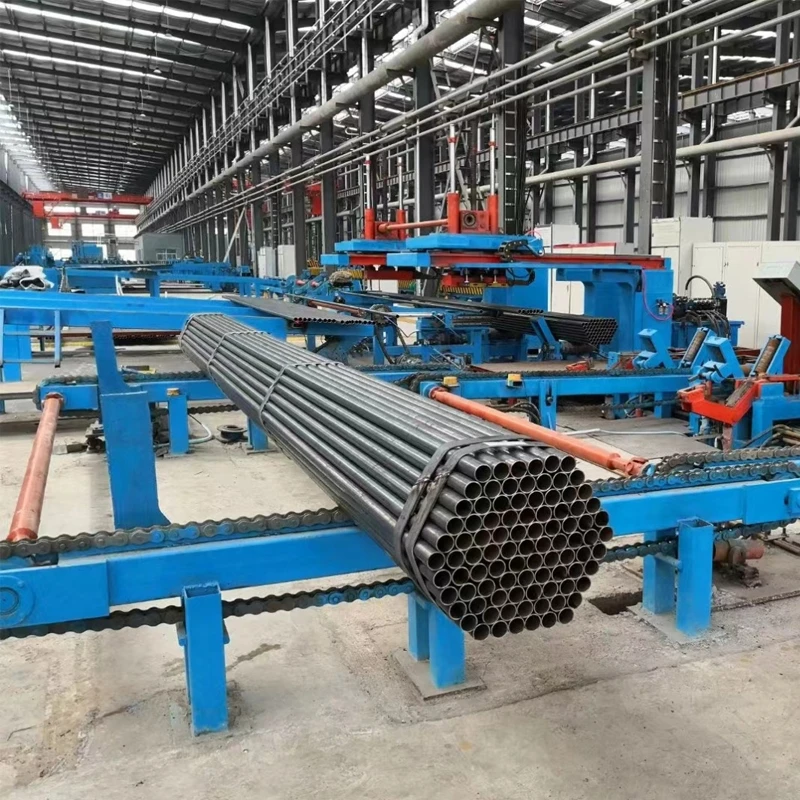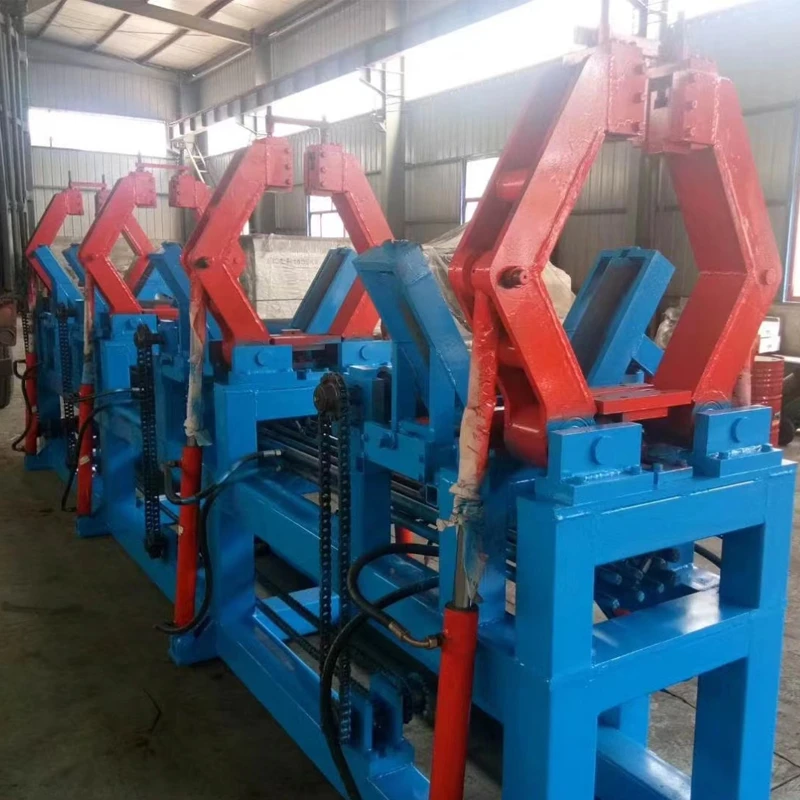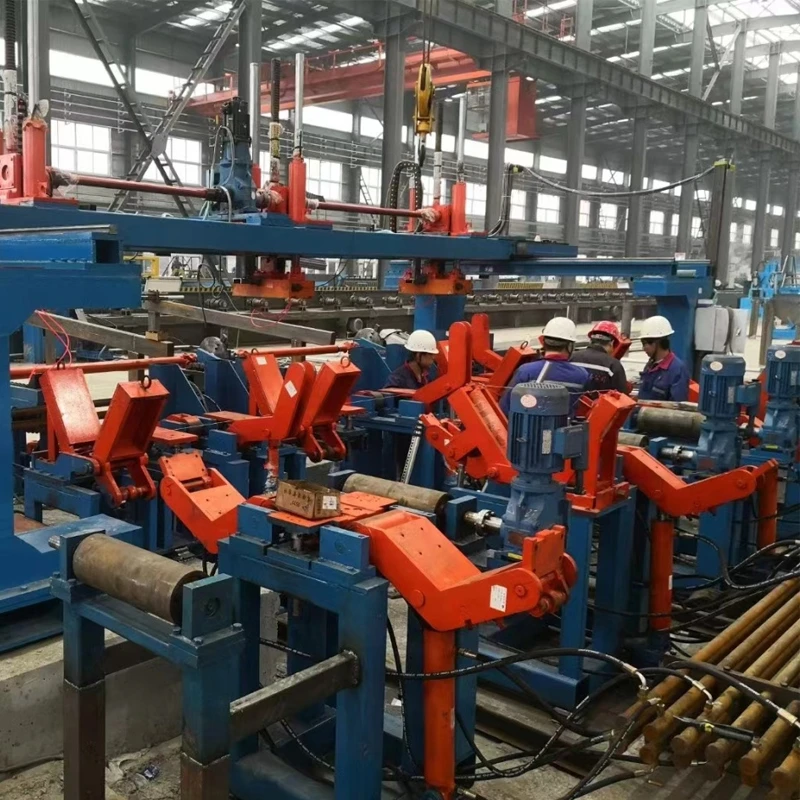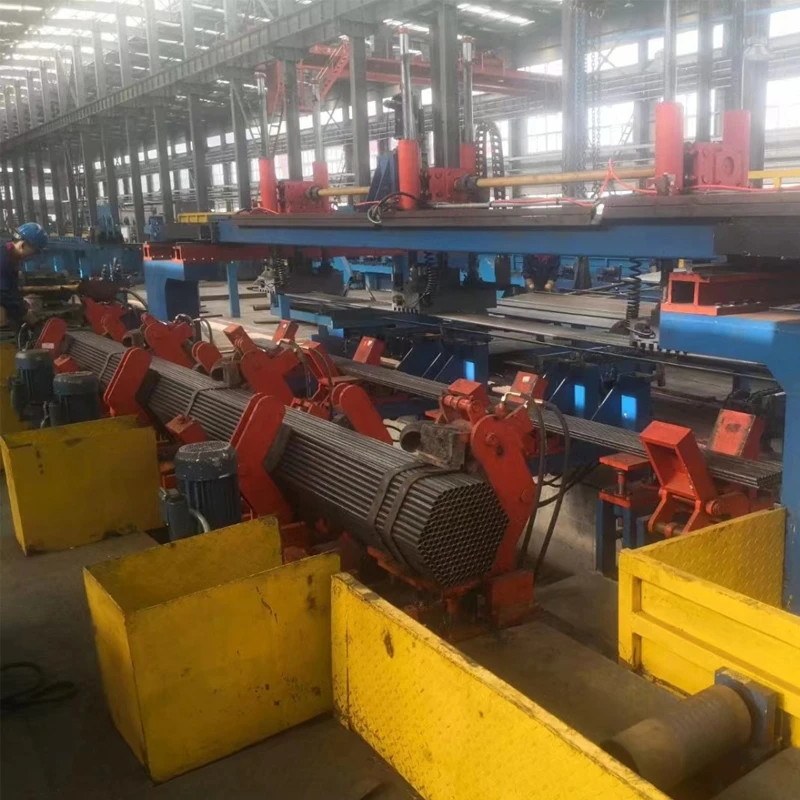Advanced Belling Machine: Precision Pipe Forming Solutions
Industry Trends and the Evolution of Pipe Belling Technology
The global demand for high-quality, durable, and efficiently produced pipes across diverse sectors such as infrastructure, oil and gas, agriculture, and municipal water systems has propelled significant advancements in pipe processing machinery. Among these, the belling machine stands as a cornerstone in pipe manufacturing, essential for creating precise socket ends (bells) that facilitate secure, leak-proof connections in pipe networks. Current industry trends emphasize automation, precision, energy efficiency, and adaptability to a wider range of materials and pipe dimensions. Manufacturers are increasingly seeking solutions that offer high throughput without compromising on the structural integrity or dimensional accuracy of the bell. This includes the integration of advanced control systems, such as PLC (Programmable Logic Controller) and HMI (Human-Machine Interface), enabling seamless operation, real-time monitoring, and quick adjustments for varying production parameters. Furthermore, there's a growing focus on machines capable of handling new composite materials and larger diameter pipes, addressing the evolving needs of large-scale infrastructure projects and specialized industrial applications. The push towards sustainable manufacturing practices also means prioritizing machines with lower power consumption and reduced material waste, contributing to both environmental responsibility and operational cost savings. The convergence of these trends underscores the critical role of innovative belling technology in shaping the future of pipe production, driving efficiency, and ensuring the reliability of global pipeline infrastructure. This continuous evolution necessitates a deep understanding of material science, mechanical engineering, and automated control systems to meet the stringent demands of modern industrial applications, pushing the boundaries of what these machines can achieve in terms of speed, accuracy, and versatility for both traditional and emerging pipe materials, including advanced polymers and composites.
Beyond conventional applications, the evolution of belling technology is closely linked to innovations in related machinery, such as `purlin machine` for structural elements and `shutter machine` for construction, highlighting a broader trend towards integrated manufacturing solutions. While distinct in their primary functions, these machines collectively represent the drive towards precise, automated, and efficient fabrication across the construction and industrial sectors. The insights gained from optimizing processes in one area, for instance, minimizing material stress during the belling process, can often inform and improve the design and operation of other forming machines. For instance, the demand for precise dimensions and consistent quality in pipes processed by a belling machine echoes the requirements for uniform profiles produced by a purlin machine or the accurate formation of panels by a shutter machine. This cross-pollination of technological advancements helps in developing more robust and versatile equipment portfolios. The emphasis on high-speed operation, minimal maintenance, and extended operational life, characteristic of advanced belling equipment, is also a common goal across all high-performance industrial machinery. The integration of IoT (Internet of Things) for predictive maintenance and AI-driven quality control is becoming standard, ensuring maximum uptime and superior product quality across the entire manufacturing chain. This holistic approach ensures that advancements in one machine type contribute to the overall efficiency and precision of industrial production lines, catering to the increasingly complex demands of global markets and specialized engineering projects that require flawless execution and long-term reliability.

Technical Parameters and Specifications of Advanced Belling Machines
Understanding the critical technical parameters is paramount for selecting the optimal belling machine for specific production requirements. Key specifications typically include the pipe diameter range (e.g., DN50 to DN630, or 2 to 24 inches), wall thickness capacity, belling length, heating method (e.g., hot air, infrared, electric heating), and cooling system (e.g., forced air, water spray). Production speed, often measured in cycles per minute or meters per hour, is another vital metric, directly impacting manufacturing throughput. For instance, a high-performance PVC pipe belling machine might achieve speeds of 8-12 cycles per minute for smaller diameters, while larger diameter machines may operate at 2-4 cycles per minute. The machine's power consumption (kW) and overall dimensions also factor into operational costs and plant layout. Advanced models integrate precise temperature control systems, ensuring uniform heating of the pipe end, which is crucial for preventing material degradation and achieving a consistent, high-quality bell. The clamping mechanism, often hydraulic or pneumatic, must provide sufficient force to hold the pipe securely without deformation during the belling process. Moreover, the type of belling tool (e.g., male or female die, expander head) must be compatible with the pipe material and desired bell geometry, whether it's an R-type, O-type, or U-type socket. Technical specifications are the bedrock upon which efficient and reliable pipe manufacturing operations are built, requiring careful consideration of each parameter to match the machine's capabilities with the specific production demands and material characteristics, ensuring optimal performance and product quality in diverse industrial environments.
The robust design and engineering of a modern belling machine are reflected in its material selection and construction quality. High-strength steel frames, precision-machined components, and wear-resistant belling dies are standard. For instance, critical wear parts like belling mandrels might be made from specialized tool steel or heat-treated alloys to withstand repetitive thermal cycling and mechanical stress, ensuring a long operational lifespan and reducing maintenance frequency. The integration of advanced sensors and feedback loops, common in sophisticated `erw pipe machine` and other high-precision equipment, allows for real-time monitoring of parameters such as temperature, pressure, and belling depth, enabling immediate adjustments to maintain peak performance and product consistency. This level of automation significantly reduces human error and enhances overall production efficiency. The table below outlines typical technical specifications for a range of belling machines, illustrating the varying capacities and capabilities available to meet diverse industry needs. These parameters are crucial for optimizing production lines, minimizing material waste, and ensuring the final product meets stringent industry standards for dimensional accuracy and structural integrity, critical for applications ranging from municipal water supply networks to complex industrial fluid transport systems, where reliability is paramount.
| Parameter | Model A (Entry-Level) | Model B (Mid-Range) | Model C (High-Performance) |
|---|---|---|---|
| Pipe Diameter Range | DN20-DN160 (0.75"-6") | DN50-DN315 (2"-12") | DN250-DN630 (10"-24") |
| Wall Thickness | 1.5-10 mm | 2.0-20 mm | 3.0-35 mm |
| Belling Length | 50-150 mm | 80-250 mm | 150-400 mm |
| Heating Method | Electric Heating Tubes | Infrared Heating System | Multi-Zone Hot Air Convection |
| Cooling Method | Forced Air Cooling | Water Spray & Air Cooling | Integrated Rapid Water Cooling |
| Production Speed | Up to 10 cycles/min | Up to 6 cycles/min | Up to 3 cycles/min |
| Total Power | 15-25 kW | 30-50 kW | 60-100 kW |
| Control System | Basic PLC & Buttons | Siemens/Schneider PLC, HMI | Advanced PLC, Touch Screen, IoT ready |

Precision Manufacturing Process and Quality Assurance
The manufacturing of a high-performance belling machine is a meticulous process, integrating advanced engineering techniques with rigorous quality control. It typically begins with the selection of premium materials, such as high-grade structural steel for the main frame, ensuring stability and vibration dampening during operation. Precision components, including the belling dies and clamping mechanisms, often utilize specialized alloys like tool steel or stainless steel, selected for their wear resistance, thermal stability, and corrosion resistance, especially vital for machines processing PVC, PE, or PP pipes where corrosive elements might be present. Manufacturing processes employed include CNC machining for critical parts, guaranteeing dimensional accuracy to within microns, and robust welding for structural integrity. Heat treatment processes, such as tempering and annealing, are applied to enhance the mechanical properties of components, increasing their hardness and toughness, thereby extending the machine's operational lifespan significantly, often exceeding 15-20 years with proper maintenance. Surface treatments, like hard chrome plating or nitriding, are applied to wear surfaces to further improve durability and reduce friction, contributing to energy efficiency and consistent belling quality. Each stage of the manufacturing process undergoes stringent quality checks, from material inspection to sub-assembly testing and final machine calibration.
Quality control for a belling machine adheres to international standards such as ISO 9001 for quality management systems, ensuring that every machine produced meets predefined quality benchmarks. Key components, including pneumatic and hydraulic cylinders, electrical systems, and control units, are sourced from globally recognized suppliers, further enhancing reliability. Dimensional accuracy of the belling die, heating consistency, and cooling efficiency are verified using calibrated instruments. For instance, bell dimensions are measured using precision calipers and gauges to comply with standards like ISO 4437 or ASTM D3034 for PVC pipes, ensuring seamless pipe integration in field applications. Pressure testing of hydraulic circuits and thermal imaging of heating zones confirm operational safety and efficiency. Moreover, a comprehensive Factory Acceptance Test (FAT) is conducted for each machine, simulating real-world production conditions to validate performance, speed, and accuracy before shipment. This robust process ensures that the finished belling machine delivers consistent, high-quality output, capable of meeting the rigorous demands of industries such as petrochemical, metallurgy, and water supply/drainage, where pipeline integrity and longevity are non-negotiable. The meticulous attention to detail at every manufacturing and inspection stage underscores the commitment to delivering equipment that provides unparalleled performance and reliability, minimizing downtime and maximizing long-term return on investment for industrial clients worldwide.

Diverse Application Scenarios and Technical Advantages
The versatility of a modern belling machine makes it indispensable across a wide spectrum of industries and applications. In the municipal sector, they are crucial for producing pipes used in water distribution networks, sewage systems, and drainage infrastructure, where secure, leak-proof connections are critical to prevent contamination and ensure efficient fluid transport. In agriculture, belling machines facilitate the creation of irrigation pipes, ensuring reliable water delivery to crops. The construction industry heavily relies on these machines for producing pipes for electrical conduits, plumbing, and structural applications, often in conjunction with equipment like a `purlin machine` or `shutter machine` which shape other building components. For industrial applications, such as chemical processing plants and petrochemical facilities, specialized belling machines are designed to handle pipes made from advanced polymers and corrosion-resistant materials, ensuring the safe transport of aggressive fluids. The energy sector, including oil and gas, utilizes belling technology for specific pipe joining requirements, particularly in non-metallic pipe applications where traditional welding is not feasible. The inherent advantage of belling lies in creating a joint that is inherently robust, requires no external welding or adhesives, and significantly reduces installation time and costs on site. This makes it a preferred method for creating seamless and efficient pipeline systems globally, adaptable to diverse environmental conditions and operational pressures, from underground installations to exposed above-ground systems.
Technological advancements imbue the latest generation of belling machine with distinct advantages over older models and alternative pipe joining methods. Firstly, energy efficiency is significantly enhanced through optimized heating and cooling systems. For example, advanced infrared heating zones ensure rapid and precise heating, minimizing energy waste compared to traditional resistive heating. Rapid and controlled cooling systems then lock in the desired bell shape, reducing overall cycle time and increasing throughput. Secondly, superior dimensional accuracy and repeatability are achieved through closed-loop control systems and high-precision tooling. This ensures that every bell produced meets stringent international standards, preventing leaks and ensuring long-term system integrity. Thirdly, their adaptability to various pipe materials—from standard PVC, PE, and PP to specialized composite pipes—provides immense flexibility for manufacturers. This versatility means a single machine can be configured for diverse product lines, offering a strong return on investment. Finally, the longevity and low maintenance requirements of these machines contribute to lower total cost of ownership. The use of robust materials, precision engineering, and modular design allows for easier maintenance and quick part replacement, minimizing downtime. In critical infrastructure projects, such as those involving `erw pipe machine` manufactured components, the consistency and reliability offered by modern belling machines are paramount, translating directly into enhanced operational efficiency, reduced project risks, and significant cost savings over the lifespan of the pipeline system, while ensuring superior performance in demanding environments.
Manufacturer Comparison and Customization Solutions
When selecting a belling machine, discerning buyers in the B2B sector often engage in a meticulous comparison of manufacturers, evaluating not only standard product offerings but also their capacity for customization, after-sales support, and proven track record. Leading manufacturers distinguish themselves through a combination of cutting-edge technology, robust engineering, and a deep understanding of customer-specific needs. Key differentiators include the sophistication of the control system (e.g., Siemens, Allen-Bradley PLCs with intuitive HMI interfaces), the efficiency of the heating and cooling mechanisms, the durability of belling dies, and the overall build quality that contributes to machine longevity. For instance, a manufacturer specializing in high-volume production lines might offer machines with integrated automatic feeding and stacking systems, optimizing workflow. Others might focus on versatility, providing quick-change tooling systems to switch between different pipe diameters or belling types (R-type, U-type, etc.) with minimal downtime. The ability to provide bespoke solutions, such as machines capable of belling unusual pipe geometries, extremely large diameters, or handling specific composite materials, is a critical factor for clients with unique project requirements. This requires an engineering team with extensive experience in custom machine design, simulation capabilities, and rapid prototyping, ensuring that tailor-made solutions meet performance expectations and integrate seamlessly into existing production setups.
Beyond standard product catalogs, the true value of a reputable belling machine manufacturer often lies in their engineering capabilities and willingness to collaborate on custom solutions. For example, some projects may require a belling machine integrated directly into an existing extrusion line, necessitating precise synchronization and control protocols. Other clients might need specialized heating profiles for non-standard pipe materials or an unconventional belling angle for niche applications. Manufacturers with strong R&D departments can leverage their expertise in thermal dynamics, material science, and automation to design and build machines that exactly match these bespoke specifications. This involves detailed consultation, CAD modeling, finite element analysis (FEA) to predict material behavior, and rigorous testing of custom components. Furthermore, the commitment to providing comprehensive training for client personnel, detailed operation and maintenance manuals, and readily available spare parts inventories solidifies a manufacturer's reputation as a reliable partner. Clients should look for manufacturers with a demonstrated history of delivering complex custom projects on time and within budget, with testimonials or case studies highlighting their problem-solving capabilities in challenging industrial environments. This level of partnership extends beyond a simple transaction, fostering long-term relationships built on trust and mutual success, ensuring that the acquired equipment serves the client's evolving operational needs effectively.

Real-World Application Cases and Customer Experience
The practical utility and performance of a belling machine are best illustrated through real-world application cases and direct customer feedback. A prominent case involved a large-scale infrastructure project in Southeast Asia requiring vast quantities of PVC drainage pipes, ranging from DN200 to DN500. The client selected a high-capacity belling machine with an integrated pipe feeding and unloading system, enabling a production rate of over 1000 meters per hour for various pipe sizes. The machine’s precise temperature control and robust belling dies ensured consistent socket dimensions, critical for rapid on-site installation and minimizing joint failures. Feedback from the project manager highlighted a 30% reduction in installation time compared to previous methods using external couplers, attributing this efficiency gain directly to the machine's high-quality bell formation and consistent output. Another successful implementation involved a specialized belling machine for manufacturing composite pipes used in aggressive chemical transport within a North American industrial plant. This machine was custom-designed to handle the unique material properties of the composite, employing a specialized heating profile and a multi-stage belling process. The client reported zero material distortion and perfect sealing integrity, exceeding their stringent safety and performance standards for chemical resistance and leak prevention. These examples underscore the machine's adaptability and the significant operational advantages it brings to diverse and demanding environments.
Further testimonials from global clients reinforce the value proposition of advanced belling machine technology. A pipe manufacturer in Europe, producing conduits for fiber optic cables, lauded the consistency and speed of their newly installed automated belling line. They noted a significant decrease in material waste due to fewer defective bells and an increase in overall line efficiency by 25%. The intuitive HMI and remote diagnostic capabilities also reduced their maintenance costs and allowed for quick troubleshooting, minimizing production downtime. In an instance from the Middle East, a construction material supplier invested in a belling machine designed for large-diameter PE pipes (up to DN630) for a major water pipeline project. The machine's ability to create deep, robust bells crucial for high-pressure applications was a key deciding factor. The client praised the machine's reliability in extreme desert temperatures and its contribution to accelerating the project timeline due to faster pipe joining. These experiences reflect how leading-edge belling technology delivers tangible benefits: enhanced productivity, superior product quality, reduced operational costs, and increased project flexibility. The consistent positive feedback from clients across different continents and industries underscores the machine's role as a critical asset in modern pipe manufacturing, fostering long-term partnerships through reliable performance and comprehensive support, echoing the success stories often associated with `erw pipe machine` and other vital production equipment.
Trust and Authority: Certifications, Support, and Warranty
Establishing trust and demonstrating authority are paramount for B2B transactions, especially when investing in capital equipment like a belling machine. Reputable manufacturers adhere to stringent international certifications, signifying their commitment to quality, safety, and environmental responsibility. Key certifications include ISO 9001 for Quality Management Systems, ensuring consistent product quality and customer satisfaction; CE marking for compliance with European health, safety, and environmental protection standards; and often specific local certifications relevant to target markets. Partnerships with industry associations, such as the Plastic Pipe Institute (PPI) or relevant engineering societies, further underscore a manufacturer's authoritative standing and engagement with industry best practices. Manufacturers with a long operational history, perhaps 20-30 years in the industry, demonstrate stability and accumulated expertise. Independent third-party testing reports for machine performance, energy efficiency, and compliance with specific pipe standards (e.g., ASTM, DIN) provide objective data that reinforces credibility. Providing audited financial statements or highlighting significant project milestones and long-standing client relationships also contributes to building confidence with potential buyers, showcasing a reliable and sustainable business operation that can support clients for the long term. This comprehensive approach to quality and transparency is fundamental in building confidence for high-value industrial equipment purchases.
Beyond certifications, the provision of robust customer support, clear delivery schedules, and comprehensive warranty policies are critical trust builders for any belling machine acquisition. A typical delivery cycle for a standard machine might range from 8 to 12 weeks, with custom solutions requiring 16-24 weeks, depending on complexity. Transparency in these timelines, along with real-time updates, is highly valued by clients managing complex project schedules. Manufacturers typically offer a standard warranty period of 12 to 24 months for parts and labor, covering manufacturing defects and ensuring peace of mind. Extended warranty options or service contracts are often available for prolonged protection and proactive maintenance. Post-sales support is crucial, encompassing technical assistance, remote diagnostics, and on-site service by factory-trained technicians. The availability of genuine spare parts and a dedicated customer service team capable of providing prompt assistance (e.g., within 24-48 hours for critical issues) significantly minimizes potential downtime, safeguarding production continuity. This holistic approach to customer care, from initial inquiry to long-term operational support, underlines a manufacturer's commitment to partnership and ensures maximum operational uptime and longevity for the invested capital, reinforcing the client's decision to trust their equipment for critical manufacturing processes.
Frequently Asked Questions (FAQ)
-
Q: What is the typical lifespan of a belling machine?
A: With proper maintenance and regular servicing, a high-quality belling machine can have an operational lifespan of 15 to 20 years or more. Factors influencing longevity include the quality of components, the intensity of usage, and adherence to recommended maintenance schedules. Regular lubrication, timely replacement of wear parts (like heating elements and belling dies), and periodic calibration are essential to maximize service life and ensure consistent performance over decades of operation. Investing in a machine from a reputable manufacturer using high-grade materials and precision engineering significantly contributes to its durability and long-term reliability in demanding industrial environments.
-
Q: Can a single belling machine process different pipe materials and diameters?
A: Yes, many modern belling machine models are designed for versatility. They typically come with interchangeable belling dies and adaptable clamping mechanisms that allow them to process a range of pipe diameters. Some advanced machines can also handle different plastic pipe materials (PVC, PE, PP) by adjusting heating profiles, belling pressure, and cooling times through their advanced control systems. However, extreme variations in material or diameter might require specific machine configurations or dedicated models to achieve optimal results and production efficiency. Consult with the manufacturer to ensure the machine meets all your specific material and dimensional requirements.
-
Q: What kind of maintenance does a belling machine require?
A: Routine maintenance for a belling machine typically involves daily checks of heating elements and sensors, weekly lubrication of moving parts, and periodic inspection of hydraulic or pneumatic systems for leaks. Monthly or quarterly checks include cleaning filters, verifying electrical connections, and inspecting belling dies for wear or damage. Annual major servicing usually involves checking all critical components, calibrating temperature and pressure sensors, and replacing any worn-out parts. Following the manufacturer's recommended maintenance schedule is crucial for ensuring optimal performance, preventing breakdowns, and extending the machine's operational lifespan, minimizing unexpected downtime.
-
Q: What safety features are incorporated into modern belling machines?
A: Modern belling machine designs prioritize operator safety. Common safety features include emergency stop buttons, safety interlocks on guards and access panels to prevent operation when covers are open, over-temperature protection for heating elements, and overload protection for motors. Light curtains or safety mats may also be integrated in automated lines to detect personnel intrusion into hazardous zones. Hydraulic and pneumatic systems are equipped with pressure relief valves to prevent over-pressurization. These features comply with international safety standards like CE directives, ensuring a safe working environment for operators while maintaining high productivity levels.
References
- International Organization for Standardization (ISO). (2015). ISO 9001:2015 Quality management systems — Requirements.
- American Society for Testing and Materials (ASTM). (2020). ASTM D3034/D3034M-20, Standard Specification for Type PSM Poly(Vinyl Chloride) (PVC) Sewer Pipe and Fittings.
- Plastic Pipe Institute (PPI). (2023). PPI Handbook of Polyethylene Pipe, 3rd Edition.
- European Committee for Standardization (CEN). (2021). EN ISO 4437-1:2021, Plastics piping systems for the supply of gaseous fuels - Polyethylene (PE) - Part 1: General.
- Smith, J. A., & Jones, R. B. (2018). "Advanced Materials and Processing Techniques in Pipe Manufacturing." Journal of Industrial Engineering and Materials Science, 15(2), 123-138.
- Chen, L., & Wang, Q. (2019). "Optimization of Thermal Stress Distribution in Polymer Pipe Belling Processes." International Journal of Polymer Processing and Engineering, 32(4), 278-291.
-
High Quality Enamel/Pre-seasoned Camping Square Cast Iron Grill Pan-BzZhou Xinghua Machinery Equipment Manufacturing Co., LTD.NewsAug.18,2025
-
High Quality Enamel/Pre-seasoned Camping Square Enamel Cast Iron Grill Steak Pan - BzZhou Xinghua Machinery Equipment Manufacturing Co., LTD.NewsAug.18,2025
-
Automatic Pipe Belling Machine - Precision & SpeedNewsAug.18,2025
-
Enamel Cast Iron Grill Pan - BzZhou Xinghua|Customizable,DurableNewsAug.18,2025
-
Cast Iron Grill Pan - BzZhou Xinghua|Enamel Coating,Square DesignNewsAug.17,2025
-
Cast Iron Grill Pan-BzZhou Xinghua|Enamel Coating,Pre-seasonedNewsAug.17,2025


